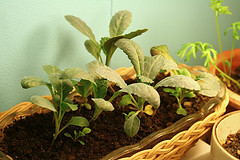Why It's Great to Grow Kale Indoors
 Kale is the "it" superfood of the 2010s, the mason jar of the vegetable kingdom. And with good reason! This dark green member of the cabbage family, whether flat-leaf or curly, packs an incredibly healthy punch. While it's become widely available in mainstream grocery stores (sales of kale have increased an impressive 400 percent since 2008), there are many advantages to cultivating it in your home garden. Even in the depths of winter, you can still enjoy fresh greens easily and inexpensively by growing kale indoors. Find out how.
Kale is the "it" superfood of the 2010s, the mason jar of the vegetable kingdom. And with good reason! This dark green member of the cabbage family, whether flat-leaf or curly, packs an incredibly healthy punch. While it's become widely available in mainstream grocery stores (sales of kale have increased an impressive 400 percent since 2008), there are many advantages to cultivating it in your home garden. Even in the depths of winter, you can still enjoy fresh greens easily and inexpensively by growing kale indoors. Find out how.
Growing Kale Indoors Is Simple
You'll need only 4 things to start your own indoor kale garden:
- a package of kale seeds
- a set of same-sized pots (important so that all the plants will be the same distance from the light)
- potting soil
- a light source -- LED is the most energy-efficient.
Sprinkle the seeds over pots full of moistened potting mixture, then cover with a thin layer of soil. When sprouts begin to appear, position the light a few inches above the pots and make sure it is on 14 hours a day. Keep the soil damp; a drip line will simplify this task.
Advantages of Growing Kale Indoors
Hardy kale tends to be quite frost-resistant and may be sown in an outdoor cold frame in the fall for early winter harvest.
However, indoor planting is fun -- for adults and kids. It also means you can pick a handful or two for supper without bundling up in your parka. (You might even want to find a handyman who'll build a special shelf for your kale plants, conveniently close to the kitchen.) Of course, growing your own organic vegetables, whether indoors or out, avoids commercial pesticides as well as the heavy carbon footprint involved in trucking produce long distances to your local supermarket.
The main disadvantage of growing kale indoors is that its amazing nutritional value will be somewhat reduced.
Enjoy Fresh Picked Baby Kale
Baby kale is more tender and tastes milder than sometimes tough, bitter mature kale, the type most commonly found at the grocery store. It also provides higher levels of Vitamin C and E. Young kale's less assertive flavor makes it great for eating raw in salads or smoothies, although it may also be juiced or cooked.
Quick sautéing, light steaming or "wilting" -- rinsing kale, then cooking covered for two minutes with no added liquid -- is an excellent way to preserve nutritional content. Pick baby leaves when they are no larger than the size of your hand. (Older leaves may be made more palatable by the use of massage -- rubbing bunches together in your hands for a minute or so before cooking.)
What Are the Nutritional Benefits Of Kale?
The question might be better phrased, "What doesn't kale provide?" This nourishing veggie is rich in vitamins A, C, and folate, as well as a host of minerals: manganese, copper, calcium, potassium, magnesium, iron, and more. It also contains a respectable amount of fiber and protein. All this is wrapped up in a dark green package that weighs in at a mere 33 calories per cup.
But where kale really shines nutritionally is with its heaping helping of Vitamin K. Named after the German word for coagulation, this littleknown vitamin plays an important role in blood clotting. It is being investigated as a preventive for coronary artery disease and osteoporosis.
HEALTH ALERT: If you are taking Coumadin (warfarin) for medical conditions such as blood clotting disorders or heart disease, large amounts of Vitamin K can be dangerous. Consult your physician regarding an appropriate diet.
Laura Firszt writes for networx.com.
Updated December 21, 2017.
Looking for a Pro? Call us (866) 441-6648

Electrical Average Costs
Electricians Experiences

Concrete Patio Is The Finishing Touch For An Artist's Studio

Lawn Repair: Contractor Followup To My DIY Prep Got The Job Done



